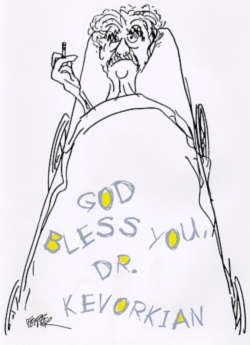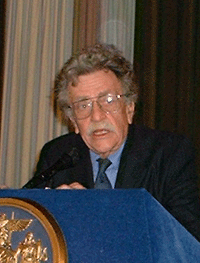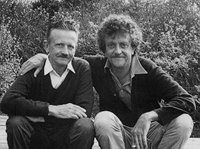AUTHOR PAGE

 KURT VONNEGUT
KURT VONNEGUT
New York State Author, 2001-2003
"It is a most agreeable honor, with my 78th birthday only a few days away, that New York State should declare so publicly that I, although born in Indianapolis, am one of its own. And it is a fact that most of my published works have been created within its borders, beginning with columns I wrote for The Cornell Daily Sun, in Ithaca, where I was a member of the class of 1944. Yes, and after my service in World War Two I went to work as a publicity man for General Electric in Schenectady, and was also a volunteer fireman in the nearby village of Alplaus. GE was the inspiration for my first novel, Player Piano, and Alplaus for my fifth, God Bless You, Mr. Rosewater. . . .I have in fact followed in the footsteps of two other native Indiana writers Booth Tarkington and Theodore Dreiser, in coming to New York for the dynamic companionship of the nearly countless world-class artists working here." - KV
 Kurt Vonnegut was born in Indianapolis, Indiana on November 11, 1922. After attending Cornell University from 1941-43 Vonnegut served in World War II and was captured during the Battle of the Bulge. As a prisoner of war, he survived the fire bombing of Dresden by Allied forces on 13 February, 1945 in an underground meat-storage cellar. When he emerged the next morning, Vonnegut was put to work pulling corpses from the ruins of the desolated city once known as "the Venice of the North." In one night the horrific fire-bombing of Dresden killed more people than the atomic bombings of Hiroshima and Nagasaki combined, more than 135,000 in all. Vonnegut's first-hand experiences of this, one of the darkest episodes in human history, would later provide the basis for his most influential work, Slaughterhouse Five (1969), though it would take him more than twenty years to come to terms with his wartime experiences and complete the novel.
Kurt Vonnegut was born in Indianapolis, Indiana on November 11, 1922. After attending Cornell University from 1941-43 Vonnegut served in World War II and was captured during the Battle of the Bulge. As a prisoner of war, he survived the fire bombing of Dresden by Allied forces on 13 February, 1945 in an underground meat-storage cellar. When he emerged the next morning, Vonnegut was put to work pulling corpses from the ruins of the desolated city once known as "the Venice of the North." In one night the horrific fire-bombing of Dresden killed more people than the atomic bombings of Hiroshima and Nagasaki combined, more than 135,000 in all. Vonnegut's first-hand experiences of this, one of the darkest episodes in human history, would later provide the basis for his most influential work, Slaughterhouse Five (1969), though it would take him more than twenty years to come to terms with his wartime experiences and complete the novel.
 After returning from the war Vonnegut attended the University of Chicago as a graduate student in anthropology. In 1947 he moved to Schenectady, New York, where he began to work on his first novel, Player Piano (1952), as well as a number of remarkably varied stories that would appear throughout the next decade in such magazines as Collier's, Playboy, Esquire and Cosmopolitan. Vonnegut's second and third novels, The Sirens of Titan (1959) and Mother Night (1961), increased his popularity among a small but dedicated following, but with the publication of his fourth novel, Cat's Cradle (1963), Vonnegut began to draw serious critical attention and broader popular appeal. Graham Greene's assessment of the book as "one of the three best novels of the year by one of the most able living writers" presaged the serious critical attention Vonnegut's later works would draw, not merely as genre fiction but as important, even formative, contributions to an ever-growing body of postmodern literature.
After returning from the war Vonnegut attended the University of Chicago as a graduate student in anthropology. In 1947 he moved to Schenectady, New York, where he began to work on his first novel, Player Piano (1952), as well as a number of remarkably varied stories that would appear throughout the next decade in such magazines as Collier's, Playboy, Esquire and Cosmopolitan. Vonnegut's second and third novels, The Sirens of Titan (1959) and Mother Night (1961), increased his popularity among a small but dedicated following, but with the publication of his fourth novel, Cat's Cradle (1963), Vonnegut began to draw serious critical attention and broader popular appeal. Graham Greene's assessment of the book as "one of the three best novels of the year by one of the most able living writers" presaged the serious critical attention Vonnegut's later works would draw, not merely as genre fiction but as important, even formative, contributions to an ever-growing body of postmodern literature.
 As critic Jerome Klinkowitz has observed: "Vonnegut's rise to eminence coincided with a shift in taste that brought a whole new reading public--and eventually critical appreciation--to the works of Richard Brautigan, Donald Barthelme, Jerzy Kosinski, and others. Ten years and several books their elder, Vonnegut by his long exile underground was well prepared to be the senior member of the new disruptive group, and the first of its numbers to be seriously considered for the Nobel Prize."
As critic Jerome Klinkowitz has observed: "Vonnegut's rise to eminence coincided with a shift in taste that brought a whole new reading public--and eventually critical appreciation--to the works of Richard Brautigan, Donald Barthelme, Jerzy Kosinski, and others. Ten years and several books their elder, Vonnegut by his long exile underground was well prepared to be the senior member of the new disruptive group, and the first of its numbers to be seriously considered for the Nobel Prize."
Elements of pathos, fantasy, didacticism and dark humor merge in Vonnegut's novels to provide an arresting mixture of entertainment and biting social critique. John Updike has praised Vonnegut as a rare "imaginer, as distinguished from a reporter or a self-dramatizer," while Jay MacInerny describes him as "a satirist with a heart, a moralist with a whoopee cushion, a cynic who wants to believe. His fiercest social criticism is usually disguised in parable." One theme that emerges consistently in Vonnegut’s works is the importance of basic human decency in a world of madness, chaos and pain. In one of Edward Abbey’s last published essays (“A Writer’s Credo,” 1989) the late satirist and literary naturalist praised Vonnegut as being among the "guard of honor" in contemporary American letters for his role as a provocative, suggestive and meaningful critic of society. The uncompromising Abbey, a grudging critic in his own right, expressed some sense of the distinguished place Vonnegut has attained in the ranks of twentieth century authors. Among a select group of writers that includes Joseph Heller, Norman Mailer and E. L. Doctorow, Vonnegut has helped to extend the range of the American novel through his innovations in tone, style and form. The best of his novels have left an indelible print on our literary landscape, inspiring generations of imitators, but no equals.
 Critics who had either ignored Vonnegut's early work or damned him with faint praise as an able "science fiction writer," came to acknowledge that he was a force to be reckoned with in contemporary literature, especially after the publication of his landmark novel Slaughterhouse Five (1969), which was recently ranked at No. 18 on the Modern Library's list of the top 100 novels of the 20th century. Doris Lessing noted in 1973: "Precisely because in all his work he has made nonsense of the little categories, the unnatural division into 'real' literature and the rest, because he is comic and sad at once, because his painful seriousness is never solemn, Vonnegut is unique among us." The critical and popular success achieved by Vonnegut at the end of the 1960s established him a a literary and cultural icon. Nearly all of his subsequent books--including Breakfast of Champions (1973), Galápagos (1985), Bluebeard (1987), Hocus Pocus (1990) and Timequake (1997, Putnam, ISBN 0-399-13737-8)--have been consistent bestsellers, and each of his fourteen novels remains in print, a remarkable feat for a writer whose career spans half a century. Kurt Vonnegut has helped to extend the range of the American novel through his innovations in tone, style, and form.
Critics who had either ignored Vonnegut's early work or damned him with faint praise as an able "science fiction writer," came to acknowledge that he was a force to be reckoned with in contemporary literature, especially after the publication of his landmark novel Slaughterhouse Five (1969), which was recently ranked at No. 18 on the Modern Library's list of the top 100 novels of the 20th century. Doris Lessing noted in 1973: "Precisely because in all his work he has made nonsense of the little categories, the unnatural division into 'real' literature and the rest, because he is comic and sad at once, because his painful seriousness is never solemn, Vonnegut is unique among us." The critical and popular success achieved by Vonnegut at the end of the 1960s established him a a literary and cultural icon. Nearly all of his subsequent books--including Breakfast of Champions (1973), Galápagos (1985), Bluebeard (1987), Hocus Pocus (1990) and Timequake (1997, Putnam, ISBN 0-399-13737-8)--have been consistent bestsellers, and each of his fourteen novels remains in print, a remarkable feat for a writer whose career spans half a century. Kurt Vonnegut has helped to extend the range of the American novel through his innovations in tone, style, and form.
Other Books by Kurt Vonnegut:










 Previous Articles:
Previous Articles:
State Author Award Presentation Transcript
Writers Online Magazine Transcript
Laureates Mark New Chapter, Times Union
Post Star Articles
Albany Times Union Article
Salon Magazine Article
For additional information, contact the Writers Institute at 518-442-5620 or online at https://www.albany.edu/writers-inst.